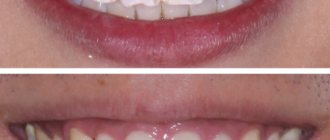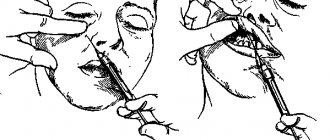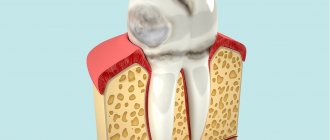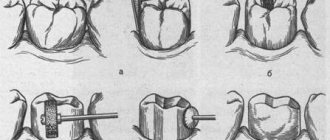The most common form of jaw injury is a bruise. No one is immune from this. For example, with a strong blow to the jaw, soft tissues, blood vessels, and capillaries are affected, resulting in the formation of hematomas and swelling. This is accompanied by severe pain and discomfort.
To avoid complications, it is recommended to consult a doctor immediately after injury. The fact is that impaired jaw function entails a chain of negative consequences: difficulties while eating, deterioration in the quality of spoken speech, etc.
What causes bruises?
Jaw injury may result from:
- falls;
- blow;
- fights;
- children's games;
- accidents, etc.
The severity of the injury is determined taking into account the following factors:
- features of the surface or object that caused the injury;
- impact intensity;
- affected area of the face;
- condition of bone tissue before the incident.
The strength of the bruise and possible complications depend on the listed indicators. Regardless of the severity, it is important to see a doctor to evaluate the condition and prescribe appropriate treatment. This will avoid unforeseen consequences and quickly restore the damaged area.
Jaw displacement
One of the most common types of injuries is jaw displacement. The fact is that it is very easy to get such an injury, sometimes even unnoticed by yourself, for example, when actively chewing food or yawning. To avoid complications and surgery, it is better to treat a dislocated jaw immediately.
The lower jaw is connected to the temporal bone by two joints, the heads of which fit into the articular fossae. This gives us the ability to talk, chew and perform other movements. Signs of a dislocated jaw appear instantly, so the problem is easily diagnosed. When the heads pop out of the articular sockets, the jaw “jams” in the open position. This is accompanied by pain in the temporal bone area.
Causes of jaw dislocation
Displacement of the lower jaw occurs for the following reasons:
- sudden movement of the jaw in the process of chewing food, laughing, yawning, screaming;
- physical impact, for example, from a fall, impact;
- unprofessional reduction of the joint - if the person tried to solve the problem on his own;
- diseases of the skeletal system and joints, such as arthritis, arthrosis, rheumatism;
- displacement due to constant excessive load on the jaws;
- congenital anomalies of the temporomandibular joint;
- opening hard packages with teeth.
How to understand that a shift has occurred
Jaw displacement is difficult to miss. Dislocation can be anterior, posterior, unilateral or bilateral. The degree of complexity of a dislocation depends on the type of injury and is expressed by the following signs:
- with anterior displacement (when the jaw moves forward), the mouth freezes in an open position, pain appears in the parotid area, profuse salivation begins, and the proportions of the lower part of the face are disturbed;
- if the dislocation is posterior (the jaw goes back), then in addition to sharp pain, it becomes difficult for the person to breathe and swallow saliva, and it is almost impossible to open the mouth;
With complicated dislocations, bleeding from the ears, hematomas in the parotid area and swelling in the joint area are possible.
How to diagnose a dislocation
An experienced doctor can easily diagnose jaw displacement using a general examination and palpation. But in order to exclude the possibility of a fracture and make the most accurate diagnosis, an X-ray examination is prescribed, as well as a computed tomography or MRI of the joint.
How to treat jaw misalignment
In most cases, dislocation is treated by manual reduction. There are several methods of treating trauma: the Hippocratic method, the Blechman method, the Popescu method and a number of others. The exact method to treat a dislocation is determined only by the doctor, depending on the specific case. The jaw realignment procedure is carried out as follows:
- The patient takes a comfortable semi-lying position so that his face is at the level of the doctor’s forearm.
- The doctor places his thumbs on the teeth and clasps the jaw from below with the rest.
- By carefully applying pressure, the specialist returns the jaw to its original position.
- As a result, the head of the joint returns to the fossa. A characteristic click occurs and the patient reflexively closes the jaw. This indicates that the problem has been resolved.
Immediately after the jaw is realigned, it is fixed with a tight bandage, which must be worn for a week. For a complete recovery and to avoid relapse, it is necessary to abstain from rough food for a while and minimize stress on the joints. As a rule, the outcome of the procedure is favorable. But in case of old or complicated injuries, surgical intervention under local anesthesia is required.
Clinical picture
First of all, the doctor conducts a visual examination of the bruised area to identify hidden injuries that cannot be identified by a person without medical education. For example, symptoms of dislocations or fractures may not appear immediately. Professional consultation allows you to begin timely treatment, if required.
To recognize a jaw bruise, it is important to pay attention to the following symptoms:
- severe pain in the place where the blow fell, intensifying when pressed;
- visual signs (eg, swelling, redness, abrasions, bruises);
- limitation of jaw mobility when yawning, talking, chewing;
- inflammation of the lymph nodes;
- general weakness.
Jaw bruises are less dangerous than more severe injuries, so recovery is usually quick.
The doctor may order an x-ray or computed tomography to establish an accurate diagnosis. These studies will assess the condition of the internal tissues of the affected area.
A little anatomy
The jaw is the most protruding part of the head, so an attack on it acts like a long lever when turning, concussing the brain with maximum force due to its impact against the wall of the skull.
A blow to the jaw also causes a concussion. The main center responsible for coordinating the body – the brain stem and cerebellum – also suffers. We must not forget that the jaw at the place of its articulation closely interacts with the ear, which, in addition to the function of hearing, is also an organ of balance. An attack to the lower jaw affects the person's balance, and he immediately falls.
Primary treatment
A bruise can be diagnosed by external signs even before seeing a doctor. To eliminate pain and discomfort, it is recommended to perform the following measures:
- apply a tight bandage;
- Apply a cold compress to the bruised area.
For quick and painless treatment, the face must be at rest. It is better to avoid warming compresses, as they can lead to the development of inflammatory processes.
The consequences of bruises can be such conditions as fractures, fractures, dislocations of the hard tissues of the jaw and even a concussion. Treatment differs depending on each case, so you should not self-medicate. It is also worth noting that most injuries have similar symptoms, so they are easy to confuse. Only a doctor can make a correct diagnosis. If you cannot go to the hospital yourself, it is recommended to call emergency medical help.
Medical care for jaw injuries
There is no specific treatment plan in such cases. But there is a list of general recommendations. Visits to the doctor are usually limited to one visit to evaluate the x-ray or CT scan.
If the patient escaped with an ordinary bruise, then treatment will be carried out at home. The patient will be given a bandage to hold the bones in the correct position. As mentioned above, you need to apply cold compresses. Ice, snow, and sterile gauze moistened with cold water are suitable for these purposes. Warming the affected area is contraindicated to avoid inflammation and worsening the clinical condition.
To eliminate pain, taking analgesics is allowed. Following simple rules will allow you to quickly get rid of the consequences of a bruise and return to your normal life.
Likely consequences
Any injury with negligence and non-compliance with medical recommendations can lead to all sorts of complications. If we talk about a bruise of the jaw, then it can develop into a post-traumatic form of periostitis, myositis or deformation of bone tissue. Any complications will require lengthy and likely expensive treatment. Injury to the masticatory muscles can cause limited mobility of the lower jaw, complicate chewing and swallowing, which directly affects the state of the gastrointestinal tract and metabolic functions of the body.
What happens to the brain after a blow to the jaw?
Since the anatomical structure of the jaw is such that certain actions can cause a concussion, it often becomes a target during a fight.
A jaw injury does not cause immediate pain, but the person often loses consciousness. This works on the principle of Archimedes' law - if you use a long lever, you can perform effective operations. The longer the lever, provided that the fulcrum is optimally present, the less force needs to be applied. Let's look at the law using the example of a blow to the jaw. At the top of the human skull is the brain. The upper jaw is its lower point. It is the same lever that, upon impact, can displace the brain. A fast and strong attack leads to such a state, and the injured person loses orientation in space and is knocked out.
The force of a blow that can knock a person out lies in this case in an impulse of energy. It starts from the legs, goes through the whole body and ends in a punch. Typically, the larger the fighter, the stronger his attack. With a half-ton impact on the skull, the brain begins to move sharply, then makes an abrupt stop, hitting the back of the head, and then the frontal lobe. Thus, the brain is injured on both sides at once, which leads to the release of hormones that usually ensure the transmission of information to neurons. This provokes a so-called electrical storm and leads to unconsciousness.
Punch a boxer in the chin
In the ring, hitting your opponent in the chin can knock him out. Often this technique is performed from below and only at a short distance. It's called an uppercut. Many inexperienced boxers often apply it incorrectly.
The reasons for this are the following:
- there are few shells for testing it,
- it is used up close, and athletes learn to fight from a distance.
Combat usually involves more direct attacks, such as crosses. It reaches the opponent much faster. And using an uppercut is risky, because the fighter’s defense is lowered for some seconds, and the enemy has the opportunity to counterattack.
In boxing, a blow to the chin, executed correctly, is characterized by rigidity and a short amplitude. It is executed with lightning speed and power from a dangerous angle.
The chin is the most common target in combat, as a clear hit on it can immediately bring victory. Other common targets include the head, liver, and spleen.
With a significant distance between opponents, the power of the attack weakens. There is no necessary bending of the arm at the elbow and proper transfer of power from it. When the hand moves correctly, the opponent is under attack. At the same time, the striking hand protects the attacking fighter’s torso from potential counterattacks.
The extension of the arm at the elbow is not full, thereby leaving powerful protection for vulnerable areas. The legs and body rotate. Their movement is identical to the impact vector. This makes it more efficient. The beating fist is turned towards you with the palm of the hand. The striking plane is formed from the knuckles of the initial fingers.
The main dangers of this process:
- It is carried out instantly for the opponent. There is almost no reliable defense against him.
- The most important areas of life are under threat. There is a risk of respiratory arrest or heart rhythm failure.
Basics of proper technique
- Knees bend. Power comes from the floor. The knees always bend. This makes attacking actions more powerful.
- When attacking, the hips are directed downward, the attack follows upward, into the enemy. The source of power is the rotational movements of the hips and body. To generate the necessary force, the fighter keeps his hips low.
- The hips generate power from the floor through rotation. The fighter rotates his feet and pushes off his shin to execute the strike. Here the principle is simple: the same shin, the same hand (right - right, left - left). The heel of the foot, which does not direct energy into the process, moves to the floor. The hips rotate. And the blow receives impulse from the entire body and shoulders. The image below reflects these aspects (sample 1).
- Impact ejection. The hand relaxes as it quickly descends to the desired angle for the attack. The palm is turned upward. The arm is thrown out synchronously with the rotational movements of the body, it is not tense. The fist clenches upon contact with the target.
- Calculated contact. The fist clenches. As soon as the hips complete their rotation, the fist immediately hits the target. In this case, the left heel touches the floor. Execution with the left is done in reverse.
- After passing a certain distance, the hand immediately returns back: to your chin, or falls down. In the second case, the next uppercut is prepared. The important thing here is to make sure that your uppercut has an end point and doesn't end up behind it (see pattern 2)
Briefly about a direct hit
To win, you can use a direct defeat - a jab. It is carried out like this: the fighter is in a standard stance. Then he sharply directs his fist at the target. Until the arm is completely straightened, it is half relaxed. Upon contact with the target, the fighter tenses it as much as possible and directs all the force into the fist.
If you hit with your right hand, then when throwing it out, take a short step forward with your left foot and transfer your body weight to it. Move the top of the body forward as well. After carrying out the attack, quickly take the initial stance.











